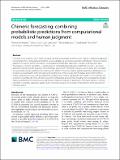| dc.contributor.author | McAndrew, Thomas | |
| dc.contributor.author | Codi, Allison | |
| dc.contributor.author | Cambeiro, Juan | |
| dc.contributor.author | Besiroglu, Tamay | |
| dc.contributor.author | Braun, David | |
| dc.contributor.author | Chen, Eva | |
| dc.contributor.author | De Cèsaris, Luis E. U. | |
| dc.contributor.author | Luk, Damon | |
| dc.date.accessioned | 2022-11-14T12:52:44Z | |
| dc.date.available | 2022-11-14T12:52:44Z | |
| dc.date.issued | 2022-11-10 | |
| dc.identifier.uri | https://hdl.handle.net/1721.1/146367 | |
| dc.description.abstract | Abstract
Forecasts of the trajectory of an infectious agent can help guide public health decision making. A traditional approach to forecasting fits a computational model to structured data and generates a predictive distribution. However, human judgment has access to the same data as computational models plus experience, intuition, and subjective data. We propose a chimeric ensemble—a combination of computational and human judgment forecasts—as a novel approach to predicting the trajectory of an infectious agent. Each month from January, 2021 to June, 2021 we asked two generalist crowds, using the same criteria as the COVID-19 Forecast Hub, to submit a predictive distribution over incident cases and deaths at the US national level either two or three weeks into the future and combined these human judgment forecasts with forecasts from computational models submitted to the COVID-19 Forecasthub into a chimeric ensemble. We find a chimeric ensemble compared to an ensemble including only computational models improves predictions of incident cases and shows similar performance for predictions of incident deaths. A chimeric ensemble is a flexible, supportive public health tool and shows promising results for predictions of the spread of an infectious agent. | en_US |
| dc.publisher | BioMed Central | en_US |
| dc.relation.isversionof | https://doi.org/10.1186/s12879-022-07794-5 | en_US |
| dc.rights | Creative Commons Attribution | en_US |
| dc.rights.uri | https://creativecommons.org/licenses/by/4.0/ | en_US |
| dc.source | BioMed Central | en_US |
| dc.title | Chimeric forecasting: combining probabilistic predictions from computational models and human judgment | en_US |
| dc.type | Article | en_US |
| dc.identifier.citation | BMC Infectious Diseases. 2022 Nov 10;22(1):833 | en_US |
| dc.contributor.department | Massachusetts Institute of Technology. Computer Science and Artificial Intelligence Laboratory | |
| dc.identifier.mitlicense | PUBLISHER_CC | |
| dc.eprint.version | Final published version | en_US |
| dc.type.uri | http://purl.org/eprint/type/JournalArticle | en_US |
| eprint.status | http://purl.org/eprint/status/PeerReviewed | en_US |
| dc.date.updated | 2022-11-13T04:15:55Z | |
| dc.language.rfc3066 | en | |
| dc.rights.holder | The Author(s) | |
| dspace.date.submission | 2022-11-13T04:15:55Z | |
| mit.license | PUBLISHER_CC | |
| mit.metadata.status | Authority Work and Publication Information Needed | en_US |
